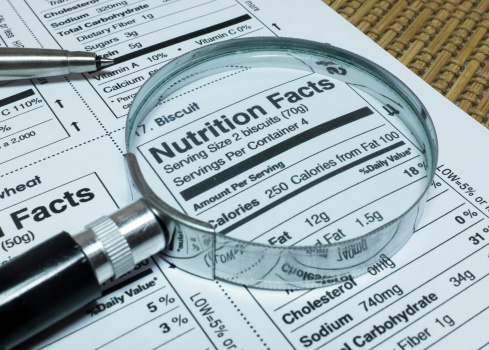
Proposed updates to label draw praise from public health groups, concern from food industry.
Fat, calories, and carbohydrates – you see each of these items listed on nutrition labels every time you walk into a grocery store. Yet if the U.S. Food and Drug Administration (FDA) has its way, these familiar labels that consumers rely upon labels to choose which foods you consume or not are about to change.
The FDA, the government agency responsible for setting guidelines for nutrition labels, has issued two proposed rules that would drastically overhaul nutrition labels in an effort to address an obesity epidemic in the United States.
Among the proposed updates are revised serving sizes, a lower suggested daily sodium intake, the inclusion of information on “added sugars” in a product, and formatting changes aimed at making the labels more user-friendly. This will mark the first major update since 1993, aside from the inclusion of trans fats in 2006.
Late last month, the FDA held a public meeting to educate the public on the proposed changes. Attendees, including representatives of public health organizations and food industry groups, offered comments that reveal the controversial nature of several of the FDA’s proposals.
For example, a new line for “added sugars” – sweeteners not naturally occurring in a food product, and that provide no added nutritional value – is highly divisive, with comments both strongly supporting and vehemently opposing it. American Heart Association spokesperson Penny Kris-Etherton joined other public health representatives in welcoming the addition, but pushed for the FDA to go further by establishing a recommended daily value for added sugars. Meanwhile food industry speakers, like Regina Hildwine of the Grocery Manufacturers Association, expressed concern for what they see as a lack of scientific basis to support the necessity of listing added sugars.
From the public health perspective, the “added sugars” change could produce significant health benefits, as such sugars comprise on average approximately sixteen percent of the total calories in Americans’ diets, yet they are entirely empty calories that people often do not know they are consuming. Yet members of the food industry point out that sugar is sugar, whether it is added or not, and they maintain that there exists no laboratory method of separately measuring naturally occurring sugars versus the added sugars in a food or beverage.
Perhaps the most noticeable change that the FDA proposes would be a revamped design of the nutrition facts panel, which highlights information about calorie content and serving sizes in bold font. The FDA is also seeking comment on an “alternative format” that would sort nutrients into categories, including a “Get Enough” section and an “Avoid Too Much” section. Public health groups, including the Consumers Union and the Center for Science in the Public Interest, touted the alternative design’s potential to help consumers quickly interpret a product’s nutritional value. Meanwhile, industry representatives from the Food Marketing Institute and the Specialty Food Association opposed the alternative format at the public meeting.
Serving sizes would also be recalibrated. For some foods, like yogurt, they will actually decrease, while others, such as for ice cream, will increase. The proposal cites the FDA’s duty under the Federal Food, Drug and Cosmetic Act (FD&C Act) to set “a serving size that reflects the amount of food customarily consumed” by Americans, rather than how much they should be eating. Current serving suggestions are based on typical portion size data collected in the 1970s and 1980s, and no longer reflect reality.
Significantly, the proposed rules also require containers of food or beverages usually consumed in a single sitting to be labeled as a single serving. For example, under the proposed standards, a twenty-ounce bottle of soda would be labeled as a single serving rather than the two-and-a-half servings listed on bottles today. The FDA reasons that this will make it far easier for consumers to keep track of how much they are eating or drinking at once.
Vitamin D and potassium would become mandatory on each nutrition facts label. They have been deemed “nutrients of public health significance,” as deficiencies can create a risk of serious health problems – Vitamin D benefits bone health and potassium lowers blood pressure – and some groups of Americans are not consuming enough of them. Iron and calcium will remain fixtures on the labels, while vitamins A and C will no longer be required on each label, since the FDA states that deficiencies in these vitamins are rare.
The proposed rules lower the recommended daily intake of sodium from 2,400mg to 2,300mg. However, the FDA is also asking for comment on a 1,500mg recommended daily intake. Several health groups strongly urged the FDA to adopt the lower limit, particularly given the strong linkage between sodium intake and high blood pressure – a major cause of heart attacks. A representative of the Center for Science in the Public Interest noted that because recommended intakes are typically based on the most vulnerable subset of the population, it makes little sense to set the daily value for sodium so high when public health would be better served by adopting the lower, 1,500mg value. That lower value is already recommended for roughly half of the U.S. population by the Dietary Guidelines for Americans, issued jointly by the Department of Agriculture and the Department of Health and Human Services.
Confronting a national obesity epidemic – nearly sixty-eight percent of adults and thirty-two percent of children in the U.S. are overweight or obese – the FDA has proposed these rules in an effort to help combat the problem by providing greater accessibility of nutritional information to consumers. The agency’s data suggests that forty-two percent of working-age adults in the U.S. use nutrition labels at least most of the time. Yet their testing showed that using the current labels many people were unable to interpret the nutrients in a given product.
First Lady Michelle Obama has said that the goal of the updates is to make nutrition labels simple, so that you can “pick up an item off the shelf and be able to tell whether it’s good for your family.”
The FDA is hoping not just to aid consumer awareness, but potentially to influence food industry behavior as well. When trans fats became mandatory on nutrition labels in 2006, many manufacturers responded by reducing or eliminating the amounts of trans fats in their products in an effort to look good next to competitors. The FDA and public health groups are hoping that the proposed changes, particularly the new line for added sugars, will have a similar effect on producers.
Despite the recent public hearing, it may take years before nutrition labels on products in grocery store aisles look different. The FDA published its proposed rules in March, but has already extended the public comment period through to the beginning of August. After that, it could take perhaps another year for the agency to issue a final rule. According to proposed rules, the agency is likely to offer a two-year implementation period to allow industry to update all of its products’ labels. However, food industry representatives at the public meeting stated they would need between three and five years to comply.
It is also possible that litigation will follow the agency’s completion of its rulemaking, thus delaying implementation still further. Although changes clearly appear to be coming, it may be quite a while before the nation reaps any health benefits from new nutrition labels.



